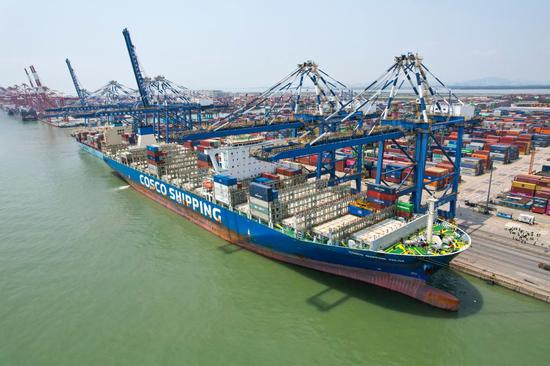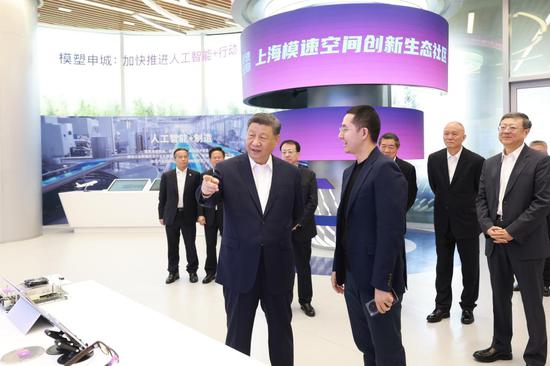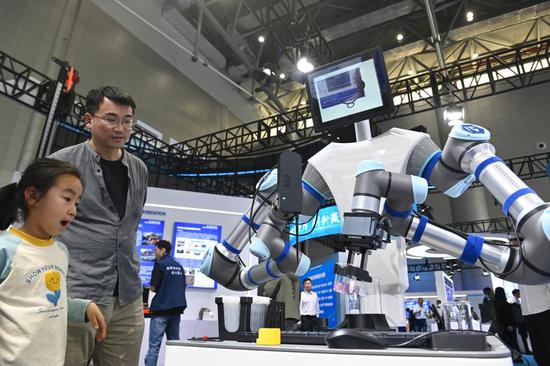Browsing through social networks, there are various posts from those able to conduct experiments or even visit the Shanghai Synchrotron Radiation Facility in Zhangjiang of Pudong New Area, with their excitement readily apparent.
Indeed, the nautilus-shaped large sci-tech infrastructure that reveals the mysteries of the microscopic world has become a landmark in Pudong. But of course, it is doing much more than merely providing aesthetic value. Frontier research on virus structures, paleontological fossil evolution and metal fatigue testing of aircraft engine blades, among others, can be conducted here as the luminescence of the light emitted at the facility is much stronger than that of ordinary X-rays.
As the first third-generation synchrotron light source in the Chinese mainland, which opened to users in May 2009, the facility has been used by more than 60,000 researchers from about 700 research institutions and companies, supporting over 20,000 projects. It has thus set a record in China in terms of the number of users and output by a large scientific facility.
The SSRF is one of nine large scientific projects in Zhangjiang to advance the area's innovation at a very fundamental level.
But Zhangjiang has bigger plans. Projected to become a global first-rate sci-tech innovation center by 2030, Zhangjiang is now home to two national-level laboratories, more than 20 national and municipal research institutes, and over 100 incubators.
Companies' business results can prove the importance of such high-tech assets. While the 22,000-plus Zhangjiang-based companies reaped about 1.3 trillion yuan ($179 billion) in total sales revenue last year, more than half of the income came from the three emerging industries of integrated circuits, biomedicine and artificial intelligence.
But higher targets have been set. During a promotion conference held on April 18, celebrating the 35th anniversary of Pudong's reform and opening-up, local government officials said that the average annual growth rate of the three emerging industries in Zhangjiang, which now employs over 400,000 people, should exceed 10 percent by 2030.
At least three technologically advanced companies with a respective annual sales revenue of 100 billion yuan and another 10 companies generating a minimum 10 billion yuan of income each year should be fostered in Zhangjiang in five years' time, said the local officials.
To achieve these goals, overall industrial planning will be optimized in Zhangjiang in the first place, directing more resources to the three emerging industries and future-oriented sectors such as synthetic biology. Large science projects and various new types of innovation institutions should play a bigger role. Zhangjiang will also offer 500,000 square meters of workspace for startups and another 500,000 sq m of industrial space with reduced or no rental fees.
Qualified talent is indispensable to higher levels of innovation. Qi Yuxia, director of Pudong's talent office, said that 1 million sq m of apartments and another 1 million sq m of startup space — both offered at lower rentals — will be introduced in the near future. Talent is entitled to favorable policies regarding household registration, medical services and children's education under Pudong's "Pearl Plan", Qi said.
"The purpose is to build Pudong as the first stop for embodying entrepreneurial dreams," she said.
Wu Jincheng, head of Pudong New Area government, said Pudong has been dedicated to creating an innovative ecosystem which bears much resemblance to a "rain forest", with Zhangjiang serving as the origin.
The establishment of a service ecosystem is thus crucial. A number of professional service providers have been founded in Pudong to provide one-stop services to technologically advanced companies. An intellectual property protection center and an international IP management platform have been built in Pudong, which are also vital to technological innovation, said Wu.
The importance of the financial sector should not be overlooked either. A complete services system linking angel funds, venture capital, and fund of funds focusing on technology innovation and secondary funds have been developed in Pudong.
"The establishment of the tech-heavy STAR Market at the Shanghai Stock Exchange has largely facilitated China's technology innovation. Under the same logic, the close ties between Zhangjiang and Lujiazui, where various financial companies are based, allow the financial sector to better empower technology innovation in Pudong," said Wu.


















































 京公網安備 11010202009201號
京公網安備 11010202009201號